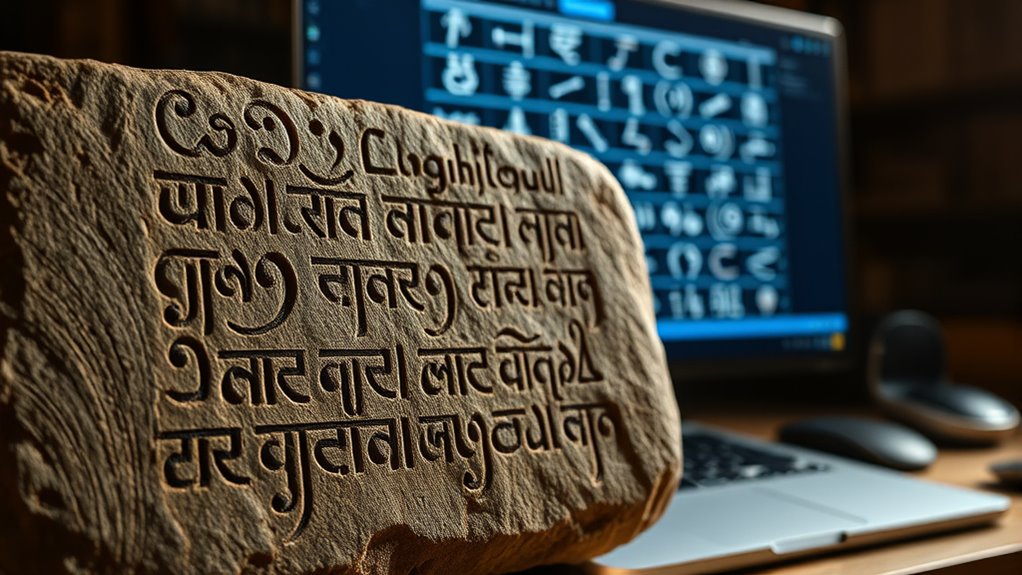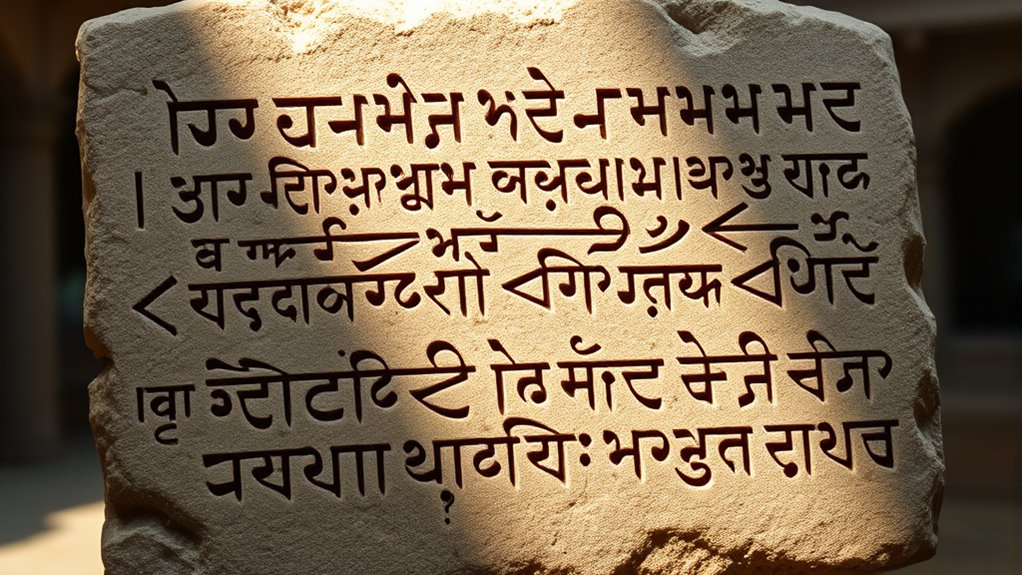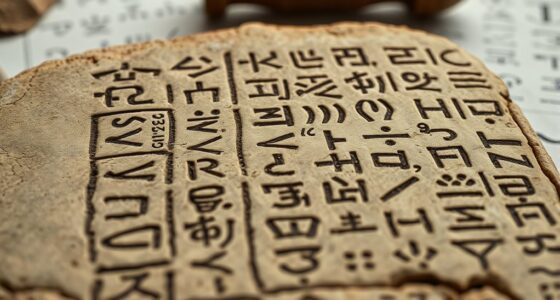Using AI and machine learning, researchers are making advances in understanding the mysterious Indus Script. These technologies analyze large datasets of symbols, recognize recurring patterns, and compare motifs across cultures, increasing the chances of decipherment. While a complete translation is still out of reach, each breakthrough brings us closer to uncovering the civilization’s stories and knowledge. If you’re curious about what AI might reveal next, there’s much more to explore.
Key Takeaways
- AI analyzes large datasets of Indus inscriptions to identify recurring symbols and patterns beyond human recognition.
- Pattern recognition helps uncover hidden relationships between symbols, potentially revealing their meanings.
- Cross-cultural comparisons through AI may identify influences or similarities with other ancient scripts.
- AI-driven trade analysis links symbols to specific goods, providing insights into social and economic structures.
- Advances in machine learning increase the likelihood of finally deciphering the Indus Script’s messages.

Have you ever wondered if modern technology could reveal the secrets of the ancient Indus Script? For years, this mysterious system of symbols has puzzled archaeologists and linguists alike. The Indus Valley civilization thrived over 4,000 years ago, yet we still struggle to understand what its symbols truly represent. With advancements in AI and machine learning, there’s renewed hope that we might finally decode these ancient symbols and unbar their messages.
One promising area is applying AI to analyze the script’s symbols and patterns. By feeding large datasets of inscriptions into sophisticated algorithms, you can identify recurring motifs and relationships between symbols. This process, known as symbol decoding, involves training AI models to recognize patterns that might be invisible to the human eye. The goal is to find correlations between symbols and possible meanings, much like how modern technology has unraveled other ancient scripts such as Egyptian hieroglyphs.
AI analyzes inscriptions to uncover hidden symbol patterns and meanings, unlocking secrets of ancient scripts like the Indus Valley.
AI also offers the potential to analyze the context of ancient trade. Many Indus artifacts have been found at distant sites, indicating a complex network of trade routes. Understanding what was traded and what symbols represented can shed light on the civilization’s social and economic structure. For example, if certain symbols consistently appear on seals linked to trade goods or commodities, AI can help establish connections that point to their meaning—perhaps identifying symbols for specific items or trade practices. This insight could revolutionize our understanding of the Indus economy and societal organization.
Furthermore, AI-driven pattern recognition can compare Indus symbols with those from other ancient cultures, looking for similarities or influences. This cross-cultural analysis might reveal shared motifs or symbolic meanings, helping to contextualize the script within a broader prehistoric worldview. As you follow this research, it becomes clear that AI is not just a tool for pattern recognition but a bridge to understanding the cultural and functional aspects of the script.
In addition, advancements in AI are increasingly utilizing machine learning algorithms to enhance decoding efforts, making the analysis more efficient and accurate. While we aren’t yet able to read the Indus Script definitively, these technological advances are promising. Each breakthrough in symbol decoding brings us closer to understanding what the Indus Valley people wanted to communicate. As you watch this unfold, it’s exciting to think that AI might one day unbar the language of one of the world’s earliest sophisticated civilizations, revealing stories of ancient trade, daily life, and cultural exchange long buried in symbols.
Frequently Asked Questions
How Long Has the Indus Script Remained Undeciphered?
You might wonder how long the script symbols of the Indus Valley remain an undeciphered mystery. Since their discovery in 1920, they’ve challenged scholars, with no definitive translation achieved. Despite numerous efforts, the symbols’ meaning stays elusive, leaving researchers puzzled for over a century. Their undeciphered status continues to spark curiosity, and recent advancements in AI hold promise for finally unraveling this ancient script’s secrets.
What Are the Main Challenges in Translating the Indus Script?
They say, “A picture is worth a thousand words,” but with the Indus script, its complexity makes translation tough. You face challenges like script complexity and limited inscriptions, which hinder deciphering efforts. Without enough examples, understanding symbols remains elusive. AI can help, but it’s not a silver bullet. You need more data, context, and insights to crack this ancient code, turning symbols into stories.
Have Any AI Models Previously Attempted to Decode Ancient Scripts?
You might wonder if AI models have tried decoding ancient scripts before. They’ve indeed used machine learning for script analysis, applying pattern recognition and data training to understand symbols. These efforts focus on identifying structures and similarities, helping researchers make progress. While previous attempts have shown promise, translating complex scripts remains challenging, but ongoing advancements in AI and machine learning continue to push the boundaries of what’s possible in deciphering ancient languages.
Could AI Translation Reveal New Insights Into Indus Valley Civilization?
They say “knowledge is power,” and AI breakthroughs in script analysis could uncover secrets of the Indus Valley Civilization. By applying advanced algorithms, you might reveal new insights into their language, culture, and society. While challenges remain, AI’s potential to decode ancient scripts promises to deepen our understanding and bring the past to life, offering answers long hidden in history’s shadows.
What Future Developments Are Needed for AI to Succeed in Deciphering the Script?
You need advancements in machine learning and linguistic analysis to succeed in deciphering ancient scripts like the Indus. Future developments should focus on improving algorithms that can recognize patterns and contextual clues within the script. By refining these technologies, you’ll enable AI to better understand language structures, making translation more accurate. This progress will open deeper insights into lost civilizations, bridging gaps in history and expanding your knowledge of human cultural evolution.
Conclusion
Imagine the Indus script as a locked treasure chest, its secrets waiting to be uncovered. With AI as your key, you’re finally turning the tumblers that once seemed impenetrable. As you forge ahead, each breakthrough feels like discovering a sparkling gem hidden within the depths. Soon, the mysteries of this ancient language could unfold like a map leading you through time, revealing stories long buried. The future of understanding the Indus script is now within your grasp.









